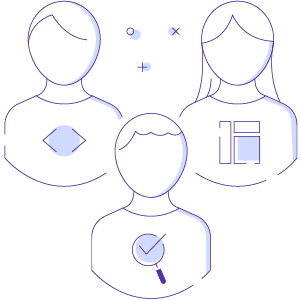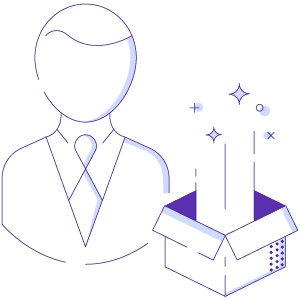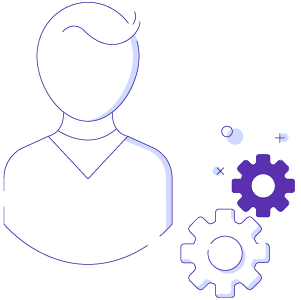Introduction
Scrum is one of the most widely known frameworks to apply Agile for software development. It’s so popular that lots of people mistake it to be Agile itself. Though in reality, it’s not. There’s a number of various frameworks used to implement Agile, but Scrum is so popular because of its unique approach to development as a process of constant iterations.
What is Scrum?
Scrum is an agile framework for managing work processes, mainly in the sphere of software development.
Agile is a set of values and principles that offer a brief explanation of how the team should interact and build their communication to build a product, not giving any specifications, just recommendations. Whereas Scrum offers further definitions and extensive explanations about how to implement a range of software development practices.
Despite the fact that Scrum was created as a part of Agile, it has become the most preferred framework for the Agile approach to the development of software product. In fact, Scrum has become so common it is often referred to as Scrum development.
What is so special about Scrum?
With Scrum development there is no set team leader and no detailed set tasks, instead, the development team sits together and discusses how everything on the project should be done. Therefore, avoiding the possible drawbacks e.g. constantly changing requirements no one is aware of, underestimated tasks, hidden costs, inaccurate tracking of the progress, etc.
On the contrary, the transparency of the Scrum framework in software development helps the team to deliver what is expected exactly on the time it is expected by the client, while frequent Sprint reviews allow to quickly make adjustments that would work better.
All in all, Scrum is a framework picked up by a self-organized team of skilled software developers who are competent to decide the best way to solve arising issues and what should be built at the beginning.
How does Scrum work?
Scrum separates the process of product creating into a series of fixed-length iterations that are called sprints (sprint usually lasts from 2 weeks up to 1 month). At the beginning of each sprint team members discuss and decide on how many items they can complete, and then create a spring backlog with a list of task to do.
During the Spring team develops, tests and runs built features, that allow them to deliver already working parts of software on a regular basis. Basically, the team and the client can see the tangible results of their work and provide feedback during the Sprint review to implement iterations that could affect the next sprint.
What are the main components of Scrum for software development?
Scrum methodology consists of several essential components that define it: specific team roles, meetings, rules, and artifacts.
Roles of the Scrum team
Scrum is meant for teams of 3 to 9 developers where everyone has equal authority and responsibilities to take crucial decisions. This way each member of the Scrum team is important for successfully implementing the project from an idea to a finished app.

1. Development Team
The key to a perfect Scrum development team is self-organization. These guys have to approach the project with a string “we” attitude, understanding their share in the project’s success.
Such teams consist of members of various skill sets who share their knowledge with other members to keep everyone on track with what is going on. This way each member can give a helping hand if something goes south to make sure sprint tasks are delivered on time.
Scrum is not meant for coders who are used to do what they are told. Instead, it broadens the traditional definition of the common programmer to anyone who somehow participates in the creation of the product.

2. Product Owner
The product owner is the project’s main stakeholder, who is either the internal or external initiator of the product development. They are responsible for a project’s backlog and revision of the final work.
Usually, Product Owners take care of:
- Drawing and looking after a project’s backlog
- Works closely with business and the team so everyone is aware of their place on the project
- Help the team around with understanding the product and what features to build next
- Set the timeline for project finalization
This being said, a Project Owner is not your typical project manager, they are focused on delivering the value to the business, and not just following the project development process.

3. Scrum Master
Scrum Master is the one who helps make sure the team follows Scrum rules and best practices. They put efforts into making everything run smoothly by facilitating meetings, removing obstacles, and looking over the backlog together with the Product Owner.
One of the most important tasks of the Scrum Master is to protect the team from the abruptly changed sprint after it has already started. Quite often the product owner can come up with “how about we fit that one super important small feature in this sprint?”, if then the team okays that the whole sprint falls apart taking down the deadline of the product and whatever was planned before.
Scrum Events
Scrum software development means that a project is developed through a sequence of sprints each of which consists of four special events:
Sprint Planning
Sprint Planning is a special team meeting at the beginning of each spring to determine what and how the certain features out of the backlog will be developed.
Daily Stand-up
The daily stand-ups are short meetings for no more than 15 minutes meant for team members to quickly exchange their progress or seek help with any problems they may come upon.
Sprint Review
The sprint review happens at the end of each sprint to see the completed work and evaluate it. Here product owner analyses the work according to the acceptance criteria to make sure it matches the current business needs.
Retrospective
The final meeting of each sprint called to help determine what went well, what didn’t, and how to avoid similar problems in the next sprint.
Scrum Artifacts
- Product Backlog describes every requirement for a software product the team is going to work on.
- Sprint Backlog describes a list of items from taken the Product Backlog to be developed during a particular spring.
- Increment is the collection of all items out of the Product Backlog that has been developed after the last software release. The team is responsible for including every item to the Increment, while the Product Owner decides when this document is released.
Scrum rules
Actually, there are no set rules to the Scrum software development. The team gets to set up their own rules coming from what is the most important from them and the project.
Summary
Agile teams use a pull model, where the team gets to decide how much work they can pull off the backlog during a sprint. This type of approach to software development allows to maintain the quality of the product and makes sure team works in a comfortable pace.
No one gets to push the team into doing more than they can handle, respecting their opinion on the project.
We, at IDAP, apply some of these principles ourselves, while mixing up bits of other frameworks coming up with our unique system. Contact us to find out more about how we do business, or simply check out How we work.



